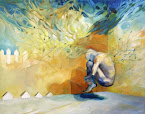The film utilized a pretty varied array of shots for different kinds of scenes. In the beginning, there were off-screen helicopters that we could hear before we could see. The battle-ravaged jungle would fade out as sequences of Captain Willard's face and the whirring ceiling fan which he was facing would fade in, and vice versa. In between the fading in and out the images would be superimposed on one another, and this was a recurring phenomenon throughout the film. It was a way to seamlessly weave shots together, but it also may have represented an emotional state which most of the characters shared. I felt as though the days sort of just dragged on for those men.
There were close-ups for character revelation and dialogue, and crane shots for the helicopter fly-ins and skirmishes. Medium shots were instructional and long shots were contemplative, especially towards the end.
Colors seemed very important in the storytelling, not only because it took place in the Vietnamese and Cambodian jungle, but because the point of the story was that nothing is ever clean-cut black and white. Red and orange were probably the most prevalent because of the associations and presence of blood and fire. Shadows and night were also powerful elements. The shadow was mostly utilized when Willard finally met Kurtz. For most of that scene, neither the audience nor Willard could see his face for the shadow covering it.
I felt that this film emphasized the value of representation more than it did presentation, and I definitely experienced it as an example of presence. The presence wasn't so much the made up of the characters as it was created by the emotional and mental states of the characters.
Sunday, September 27, 2009
Subscribe to:
Post Comments (Atom)

No comments:
Post a Comment